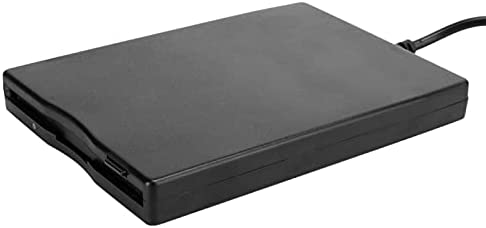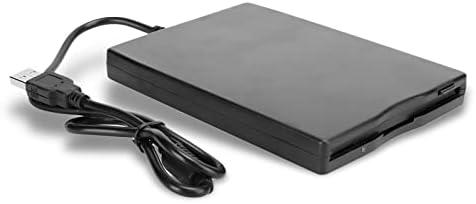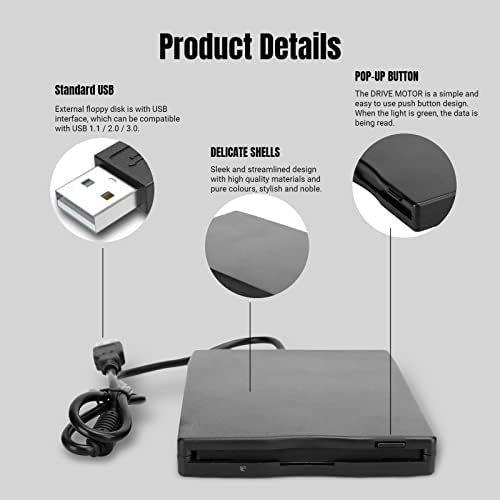Portable Floppy Drive: A Must-Have Computer Accessory

A portable floppy drive is a computer accessory that is often overlooked in today’s technological era, but it is still an essential tool for many who are still using older computers or dealing with legacy systems. In this review, I’ll be discussing the advantages of using a portable floppy drive and why it’s still relevant in today’s computing systems.

What is a Portable Floppy Drive?
For those who are unfamiliar with what a portable floppy drive is, it’s a type of external storage device that allows you to read and write 3.5-inch floppy disks. These disks were a popular form of storage in the ’80s and ’90s, and while they are no longer the primary storage medium, they are still used in many industries such as music production, manufacturing, and healthcare.

Advantages of Using a Portable Floppy Drive
Ease of Use
One of the biggest advantages of using a portable floppy drive is its ease of use. You simply need to plug it into your computer’s USB port, and you’re ready to go. There’s no need to install any drivers or software, making it an ideal plug-and-play solution.
Compatibility
Another benefit of using a portable floppy drive is its compatibility. Older computers that don’t have built-in floppy drives can use this accessory to read and write floppy disks. This can come in handy if you need to retrieve old data or transfer files between older computers.
Reliability
Floppy disks have been known to be a reliable form of storage, especially for archival purposes. While they may not hold as much data as a modern USB drive, floppy disks have a much longer lifespan and can withstand years of use without damage.

Cost-effective
A portable floppy drive is a cost-effective solution for those who need to access data stored on floppy disks. It is a much cheaper alternative to purchasing newer storage devices, especially if you only need to use it occasionally.
How to Choose the Right Portable Floppy Drive
When choosing a portable floppy drive, there are a few things to consider:

Compatibility

Make sure the portable floppy drive is compatible with your computer’s operating system. Some drives only work with Windows, while others only work with Mac.

Durability
Choose a portable floppy drive that is durable and has a solid build. You don’t want it to break after a few uses.
Speed
Choose a portable floppy drive that has fast read and write speeds. This will save you time when transferring files to and from floppy disks.

Price
Choose a portable floppy drive that is within your budget. While these drives are generally affordable, there are still some high-end options that may be more expensive.
Top Portable Floppy Drives on Amazon
1. Sabrent External USB 1.44 MB 2x Floppy Disk Drive

The Sabrent External USB 1.44 MB 2x Floppy Disk Drive is a reliable external floppy drive that is compatible with both Windows and Mac operating systems. It has fast read and write speeds and is ideal for those who need to access data stored on floppy disks.
2. Kfloppy USB Floppy Disk Drive
The Kfloppy USB Floppy Disk Drive is an affordable option for those who need to read and write floppy disks. It has a lightweight design and is compatible with both Windows and Mac operating systems.
3. Yosoo USB Emulator SFR1M44-U100K Floppy Drive
The Yosoo USB Emulator SFR1M44-U100K Floppy Drive is a high-end option that is perfect for those who need to emulate floppy disks. It has a USB interface and is compatible with a wide range of devices, including industrial control equipment and programmable logic controllers. It has fast read and write speeds and is an ideal solution for those who work in the manufacturing or automation industry.
Conclusion
In conclusion, a portable floppy drive is an essential accessory for those who still use legacy systems or work in industries that rely on floppy disks. It is a cost-effective solution that can help you access old data and transfer files between older computers. With the advancements in technology, it’s easy to overlook the importance of such a device, but it’s still relevant in today’s computing systems.

![Amazon.com: SABRENT 4 Port USB 2.0 Hub [90°/180° Degree Rotatable] (HB-UMN4) : Everything Else](https://www.coupondealsone.com/wp-content/uploads/2024/04/WT3CXiYnTVaD.jpg) Sabrent 4-Port Hub with 360 Degree Rotatable Design Review
Sabrent 4-Port Hub with 360 Degree Rotatable Design Review  Professional Review of XYZ Product
Professional Review of XYZ Product  Review of Electronic Organizer with Multiple Compartments and Accessories
Review of Electronic Organizer with Multiple Compartments and Accessories  VIVO Monitor Stand Vertical Stacked Review
VIVO Monitor Stand Vertical Stacked Review  Professional Review of Product X
Professional Review of Product X  Elevate Your Baking with the Stylish and Powerful Drew Barrymore 5.3-Quart Stand Mixer
Elevate Your Baking with the Stylish and Powerful Drew Barrymore 5.3-Quart Stand Mixer  Review of the Sterilizer Charging Wireless Certified Sanitizer
Review of the Sterilizer Charging Wireless Certified Sanitizer  DESTEK VR Controller Review
DESTEK VR Controller Review